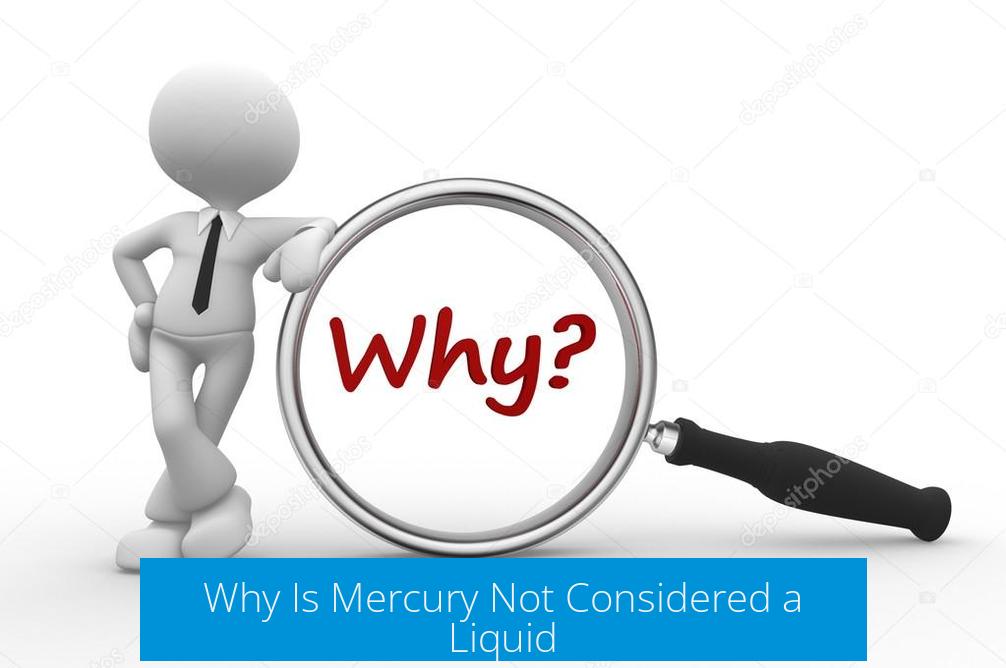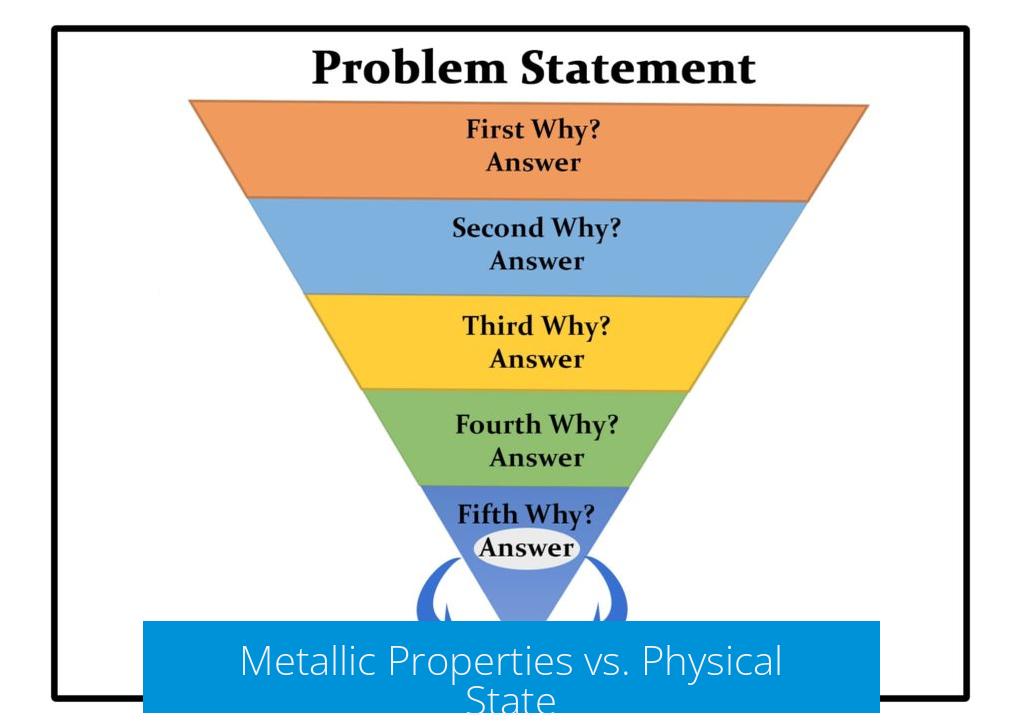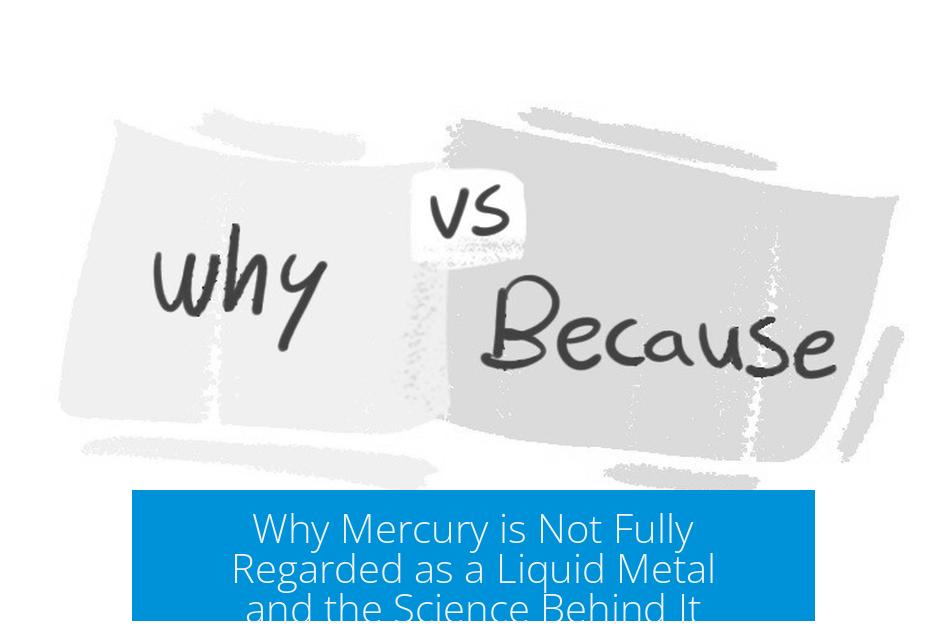Why Is Mercury Not Considered a Liquid?

Mercury is indeed a liquid metal at room temperature, so it is considered a liquid by physical state and a metal by its chemical nature simultaneously. This precise classification often causes confusion. People tend to separate the concept of metals from liquids. The main misunderstanding arises from mixing an element’s classification based on electronic properties with its state of matter.
Mercury as a Liquid Metal
Mercury is unique among metals because it remains a liquid at room temperature and atmospheric pressure. This property makes it a “liquid metal.” Being a metal and a liquid is not contradictory. At room temperature, mercury exists as a liquid with metallic conductivity and characteristics.
- Mercury atoms are held together by delocalized electrons.
- These electrons provide metallic properties such as electrical conductivity and malleability.
- Despite being a liquid, mercury retains metallic bonding and behavior.
This distinctive positioning as a liquid metal sets mercury apart from most metals, which are solids at room temperature.
Metallic Properties vs. Physical State

Whether an element or compound is a metal is based on its electronic structure, not its phase of matter. Metals have certain electronic behaviors, including free-moving electrons that create a “sea of electrons.” This enables properties like conductivity and ductility.
Melting iron produces liquid iron, which remains a metal despite its liquid state.
Thus, the classification as a metal depends on electronic properties, while physical states—solid, liquid, gas—describe the element’s current phase. Almost all metals are solid at room temperature, but phase does not define the metallic nature itself.
This distinction explains why mercury can exist as a liquid and still be metallic.
Misunderstanding of Vocabulary
The confusion often arises from mixing terms that describe material properties with those describing physical states. Metals, nonmetals, and metalloids refer to groups of elements characterized by their properties such as conductivity, magnetism, and reactivity.
- Liquid is a state of matter describing how the atoms or molecules arrange and move.
- Being a metal describes how atoms share electrons and the element’s chemical behavior.
- Both terms can describe mercury at the same time: mercury is a metal in liquid form.
In educational settings, students learn that substances can be both a metal and in any state of matter, clearing confusion about mercury’s liquid state.
Unique Atomic and Quantum Effects Affecting Mercury’s State

Two important atomic-scale reasons explain mercury’s liquid state at room temperature:
- Lanthanide contraction: This effect causes the 6s orbital electrons of mercury to be held more closely to the nucleus. The stronger pull reduces mercury atoms’ tendency to bond with each other.
- Relativistic effect: Electrons near mercury’s nucleus move at speeds around 58% of the speed of light, causing increase in relativistic mass and stronger nucleus-electron attraction. This stabilizes individual atoms and weakens metallic bonding.
These quantum effects reduce the strength of interatomic metallic bonds which normally solidify metals, leading mercury to remain liquid at room temperature.
Difference Between Mercury and Water as Liquids
Water and mercury are often compared as liquids, but fundamental differences exist:
| Property | Mercury | Water |
|---|---|---|
| Type of Substance | Element (metal) | Compound (H2O molecule) |
| Interatomic Forces | Metallic bonding with delocalized electrons | Hydrogen bonding between molecules |
| Structure | Uniform metal atoms | Molecular clusters |
| Physical State at Room Temp | Liquid metal | Liquid molecular compound |
Because mercury consists purely of one type of metal atom with metallic bonds, it behaves differently from water. Water’s unique hydrogen bonds cause it to have higher cohesion and distinct behaviors compared to liquid mercury.
Summary of Key Points
- Mercury is both a liquid and a metal at room temperature—it is a liquid metal.
- Metallic classification depends on electronic structure, not physical state.
- Physical states (solid, liquid, gas) describe how atoms or molecules behave at certain temperatures and pressures.
- Quantum and relativistic effects weaken mercury’s interatomic bonds, keeping it liquid at room temperature.
- Mercury as a liquid metal differs fundamentally from liquid water, a molecular compound.
Why is Mercury Not Considered a Liquid? Unpacking the Myth
If you ask around, you might hear some folks say, “Mercury isn’t considered a liquid.” Now, hold on a moment—this statement sounds fishy. Mercury is famously known as the only metal that stays liquid at room temperature. So, why does this confusion exist?
Let’s dive into the science behind mercury’s unique nature, clear up misunderstandings, and explore why Mercury is very much a liquid metal. Grab your curiosity cap; this journey involves quantum physics, atomic quirks, and some colorful misconceptions.
Mercury: The Liquid Metal Superstar
First things first: Mercury is indeed a liquid when you stroll around room temperature. It’s unusual because we typically picture metals as hard, shiny solids—think iron or copper. Mercury breaks this stereotype since it flows like a silvery liquid you can roll between your fingers (please don’t actually do that, it’s toxic).
Mercury is both a metal and a liquid, simultaneously. That’s not a contradiction; it’s chemistry at its finest. Its metallic properties—like good electrical conductivity and characteristic “metallic” luster—remain intact even though it’s liquid.
The secret lies in its atomic structure. Mercury consists of atoms held together by a “sea of electrons.” These delocalized electrons freely move around, giving metals their characteristic bonding, conductivity, and reflectivity.
But unlike most metals, the bond between mercury atoms is weaker. This means mercury atoms don’t lock into a rigid solid lattice at room temperature. Instead, they float past each other, allowing mercury to stay liquid without losing its metallic personality.
Metal vs. Matter State: Why It’s Never About Solid or Liquid Alone
Many people confuse “metal” with being “solid.” The truth is metal classification depends less on physical state and much more on electron behavior. Metals have loosely held electrons that move freely between atoms. This “sea of free electrons” model works for metals whether they’re solid or liquid.
Take iron, for example. Heat it enough, and it melts into liquid iron. It still behaves like a metal, carrying electricity and heat. Similarly, mercury at room temperature is a metal in liquid form. Temperature and pressure influence physical state, but don’t change elemental identity.
It’s like calling a person tall. If they sit down (change physical state), they’re still tall. The classification remains, even if their “state” looks different. Mercury proves metals don’t have to be stony solids all the time.
Let’s Talk Vocabulary: Clearing Up the Confusion
This muddle partly arises from misusing terms. “Liquid” is a physical state—how the stuff behaves. “Metal” is a classification based on intrinsic properties, mainly electron arrangement and bonding.
People sometimes think “metallic” means “solid.” It’s a bit like thinking all cakes are chocolate just because you love chocolate. Not true! Mercury is a metallic element, able to be liquid, solid, or even gas if heated. At room temperature, it happens to be liquid.
So, to recap: mercury can be liquid and metal simultaneously, without breaking any science rules. This linguistic error causes folks to say “mercury isn’t liquid,” but in scientific terms, that’s just wrong.
Why Does Mercury Stay Liquid at Room Temp? It’s Atomic Magic
Here’s where things get spectacular. Mercury liquifies at -38.83 °C, which is pretty low compared to water, which freezes at 0 °C. So why is mercury so chill (pun intended)?
Two unique atomic effects play crucial roles:
- Lanthanide Contraction: Mercury’s nucleus pulls electrons tighter than expected. This shrinks the atomic size and weakens bonding between atoms. Since atoms don’t “hold hands” tightly, the metal can’t solidify easily.
- Relativistic Effects: Electrons orbiting mercury’s nucleus zip around at speeds nearing 58% the speed of light. Albert Einstein taught us that moving near light speed increases mass, so these electrons become “heavier” and stick even closer to the nucleus. This makes the atoms self-contained and less eager to connect with neighbors.
These combined phenomena cause mercury atoms to prefer breaking away from tight structures and enjoy the freedom of liquid life. Pretty cool for a metal, right?
Mercury vs. Water: Apples to Oranges?
Sometimes people compare mercury to water, both being liquids at room temperature. But they’re fundamentally different beasts.
Water is a compound made of two hydrogens bonded with one oxygen (H2O). These molecules stick to each other using hydrogen bonds, resulting in a sticky network that’s quite resistant to flow.
Mercury, on the other hand, is a pure element. It’s just mercury atoms bonded through metallic bonds. The bonds are weak in mercury’s case, allowing atoms to glide by each other easily.
Think of it this way: water is chunky clam chowder—thick and hearty. Mercury is more like a thin chicken noodle soup—flowy and sleek. They’re both liquids, but their ingredients and bonding are worlds apart.
Putting It All Together: Mercury is Absolutely a Liquid Metal
So why is mercury not considered just a liquid? The answer is: it shouldn’t be. Mercury IS a liquid, specifically a liquid metal, due to its unique atomic and electronic properties.
This confusion mostly arises because folks mix up the concepts of chemical classification (metal vs non-metal) with physical states (liquid vs solid). Mercury teaches us a valuable lesson: physical state is a condition, while metallicity is a feature.
In short, mercury challenges the stereotype of metals and reveals the beauty of chemistry’s nuance. It’s a shining (or should I say flowing?) example that metals don’t need to be solid to be metals.
Practical Takeaway
Next time someone says, “Mercury is not a liquid,” you can flash your newfound knowledge. Mercury is a liquid metal, demonstrating unique quantum effects. It’s a perfect case study in why chemistry vocabulary matters, and nature loves diversity.
Want to impress science buffs at your next dinner? Mention lanthanide contraction and relativistic electrons—trust me, it’s a conversation starter. But be sure to remind them mercury is toxic, so admiration is best from a distance.
Mercury reminds us: labels and states are not rigid boxes but fluid concepts. And in science, that’s what makes things exciting.
Why is mercury often confused as not being a liquid?
Many confuse its metallic nature with a solid state. Mercury is a metal but at room temperature, it is liquid. Being a metal does not mean it has to be solid.
How can mercury be a metal and a liquid at the same time?
Metallicity depends on electron sharing, not physical state. Mercury shares electrons like metals do, even though it is liquid at room temperature.
What atomic effects cause mercury to be liquid at room temperature?
Lanthanide contraction and relativistic effects make its atoms weakly bonded. This prevents solid lattice formation, keeping mercury liquid.
Why is mercury not like other liquids such as water?
Water is a compound made of molecules; mercury is a pure element. Its atomic structure leads to weaker bonding compared to molecular liquids.
Does the liquid state change mercury’s chemical or metallic properties?
No. Mercury keeps all metallic properties regardless of its liquid state. Its state simply reflects temperature conditions.





Leave a Comment